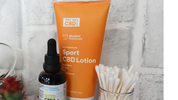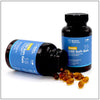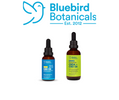CBD Labels Decoded: How to Read and Understand CBD Packaging Like a Pro
CBD products are popping up everywhere these days, making it more important than ever to know how to read CBD labels and spot fake CBD products before making a purchase. The labels on these products can be tricky to understand, especially since there's no official stamp of approval from the FDA on most of them. It's up to you to figure out what's good and what's not, which is why it's essential to understand how to spot fake CBD before you buy CBD online or in-store. But don't worry, we're here to help you make sense of those confusing labels so you can buy CBD with confidence.
Key Takeaways
-
Knowing how to read CBD labels is crucial for making informed purchases and avoiding low-quality products.
-
Look out for misleading terms that might confuse new buyers.
-
Key sections of the label include ingredients, serving size, and composition.
-
Watch for red flags like missing lab results or unclear labeling.
-
When you buy CBD from reputable sources, you reduce the risk of encountering mislabeled or fake CBD products.
Introduction: Why CBD Labels Can Be Confusing

Understanding CBD labels can feel like deciphering a secret code. Why is it so tricky? For starters, there is no universal labeling standard, leaving it up to consumers to sift through the details. This means you need to rely on your own research or third-party testing to ensure the quality of the product you're buying.
CBD products often use terms that are not standardized, leading to confusion. For example, terms like "full-spectrum," "broad-spectrum," and "CBD isolate" are common, yet many don't know what they mean. Full-spectrum means the product contains all the cannabinoids found in the cannabis plant, including THC. Broad-spectrum has all cannabinoids except THC, and CBD isolate is just pure CBD.
Moreover, some labels might not clearly state the CBD concentration, which is vital for serving amount. Without this information, you might end up taking too much or too little, affecting the product's effectiveness.
Navigating these labels can be daunting, but when you know how to read CBD labels, you’ll have a much easier time identifying authentic CBD products.
Also, the lack of standardized terminology can lead to misleading marketing. Words like "organic," "natural," or "pure" may not mean what you think. Some products might claim to be "THC-free," yet contain trace amounts that could affect drug tests.
Lastly, don't forget about the fine print. Important details about serving sizes, ingredients, and potential allergens are often buried in small text. It's crucial to read every part of the label to avoid any unwanted surprises.
In a market flooded with options, understanding these labels is key to making informed choices. Whether you're looking for a product to help with focus like Clarify CBC + CBD Oil or something for your everyday wellness routine like the All Day CBD Bundle, knowing how to read the label can make all the difference.
The Most Misleading Terms on CBD Labels
Understanding CBD labels can be tricky, especially with the abundance of terms that don't always mean what you think. Here’s a look at some of the most misleading terms you might encounter.
1. "Pure CBD"
When you see "pure CBD" on a label, you might assume it's the highest quality available. However, this term doesn't have a regulated definition. Pure could mean anything from CBD isolate, which is just CBD without other cannabinoids, to products with minimal THC. It's crucial to check the lab results to determine what you're really getting.
2. "Full Spectrum"
"Full Spectrum" sounds comprehensive, right? It suggests that the product includes a wide range of cannabinoids found in the hemp plant. However, without checking the lab report, you can't be sure of the actual cannabinoid content. Some products labeled 'full spectrum' might have negligible levels of other cannabinoids, which is why it's crucial to know how to read CBD labels before you buy CBD products.
3. "Organic"
The term "organic" is often used to imply natural and chemical-free products. But in the CBD world, not all "organic" labels are created equal. Some products might use organic hemp but are processed with non-organic solvents. Look for certifications or third-party verifications to ensure the entire process adheres to organic standards.
4. "THC-Free"
Many consumers look for "THC-Free" products to avoid psychoactive effects. However, "THC-Free" can have different meanings depending on testing methods. Some products may contain non-detectable levels of THC based on third-party lab results.
5. "Lab Tested"
"Lab Tested" is a reassuring term, but it doesn't always guarantee quality. Some companies might test their products in-house rather than using an independent, third-party lab. Always look for products with accessible lab reports from reputable third-party labs to verify the claims made on the label.
Reading CBD labels requires a bit of skepticism, an understanding of how to read CBD labels, and awareness of how to spot fake CBD in the market. With terms that can be vague or unregulated, it's on you to dig deeper and understand what you're buying. Look beyond the buzzwords and focus on verified information to make informed choices.
6. "All Natural"
"All Natural" sounds wholesome, but in reality, it doesn't necessarily mean the product is safe or effective. This term is not regulated, so it can be used freely, even if the product contains synthetic additives or preservatives. It's always a good idea to check the ingredient list for any unexpected components.
By being aware of these misleading terms, you can better navigate the world of CBD products and choose those that truly meet your needs. Remember, the key is to look beyond the label and verify the information through reliable sources.
How to Read a CBD Label Like a Pro
Understanding how to read CBD labels can be a bit tricky, but once you get the hang of it, you’ll be able to confidently buy CBD products without worry.
Check the Product Type
First things first, know what you're dealing with. Is it full-spectrum, broad-spectrum, or an isolate? Each type has different components:
-
Full-Spectrum: Contains all cannabinoids found in the cannabis plant, including up to 0.3% THC. If you are looking for a full-spectrum CBD Topical product Bluebird Botanicals’ CBD Roll-onis a customer favorite for temporary relief from localized discomfort, and sore muscles.
-
Broad-Spectrum: Similar to full-spectrum but with the THC removed (Contains 0.01% or less).
-
Isolate: Pure CBD with no other cannabinoids.
⭐⭐⭐⭐⭐
“I love this product, non greasy, smells good and more importantly it works. Less expensive than other products”
-Renne. F
Look for the CBD and THC Content
This is where you find out how much CBD and THC are in the product before you buy CBD. It's usually listed in milligrams (mg). For example, if you're buying a CBD oil for pets, you'll want to ensure it has minimal THC for safety.
Examine the Certificate of Analysis (COA)
A COA is a report from an independent lab that tests the product. It verifies the cannabinoid content and checks for contaminants. Always look for a COA to ensure you're getting what's promised on the label.
Ingredients Matter
Check the ingredients list to see what else is in the product. Some CBD oils, like the Complete CBDA + CBD Oil, combine CBD with other compounds like CBDA for enhanced effects.
Serving Size
Understand how much you're supposed to take. This is usually listed as a serving size on the label. Make sure you know the total serving size of the package too.
Pro Tip: Start with a small amount and gradually increase until you find what works best for you.
The Most Important Sections on a CBD Label
Understanding a CBD label can feel like deciphering a foreign language if you're new to it. But once you get the hang of it, you'll be able to make informed decisions about what you're putting in your body. Here are the key sections you should pay attention to:
Product Identity and Net Quantity
The first thing you should look for is the product identity, which tells you what the CBD product is or does. This is usually displayed prominently on the front. Next, check the net quantity of contents. This tells you how much product is in the package, often listed in milliliters or grams.
CBD Concentration and Serving Size
Understanding how much CBD is in each serving helps consumers choose products that align with their preferences and needs. It's usually measured in milligrams (mg) per serving or per bottle. Knowing this helps you gauge how much CBD you're consuming.
Ingredients List
The ingredients list is crucial. Always check this to ensure there are no unwanted additives or allergens. Ingredients are listed in descending order by weight, so the first few ingredients make up the bulk of the product.
Batch Code and Expiration Date
Every CBD product should have a batch code and an expiration date. The batch code is essential for tracking the product's history and finding lab reports. The expiration date tells you how long the product will maintain its potency and safety.
Manufacturer Information
Look for the manufacturer's name, address, and contact details. This info is vital if you need to reach out with questions or concerns about the product. If this is missing, it's a red flag.
FDA Disclaimer and Warnings
CBD products are regulated differently than prescription medications. Many reputable brands include disclaimers stating that their products are not evaluated by the FDA for diagnosing, treating, curing, or preventing any disease. Also, watch for warnings about usage, especially if you're pregnant, nursing, or taking other medications.
Reading a CBD label isn't just about knowing what's inside; it's about ensuring you're choosing a product that's safe for you. By understanding these sections, you'll be better equipped to make the right choice.
Being informed about these sections can help you choose a product like Bluebird Botanicals' Classic CBD Oil with confidence, knowing it meets safety standards and is free from contaminants. Similarly, products like Extra Strength Signature CBD Oil + Botanicals provide reassurance with their detailed labeling and rigorous testing.
⭐⭐⭐⭐⭐
“Signature CBD + Botanicals helps me to feel more balanced. I wasn't sure for a while if it helped but I find myself using it more regularly and appreciating it.”
-Kathleen.M
Red Flags: Signs of a Low-Quality CBD Product
When you're shopping for CBD products, it's like navigating a maze—especially if you don't know how to spot fake CBD. Some products are great, others not so much. Here's how to spot the duds.
1. Lack of Third-Party Testing
First off, if a CBD product doesn't have a Certificate of Analysis (COA), that's a huge red flag. This document is proof that the product has been tested by an independent lab. Without it, there's no real way to know what's inside. You want to ensure the product matches what's on the label. Always look for products with a COA.
2. Vague or Misleading Labels
Next, check the label carefully. It should clearly state the CBD and THC content. If it's full-spectrum, it should list other cannabinoids and terpenes. Watch out for terms like "pure" or "organic" without certification. These can be misleading.
3. Unproven Medical Claims
Be cautious of products that make unverified health claims. Reputable brands focus on transparency and quality. Stick with brands that provide honest, straightforward information.
4. Low-Quality Ingredients
Another thing to consider is the ingredient list. Avoid products with artificial additives, preservatives, or unknown substances. Opt for those with natural and organic ingredients whenever possible.
5. No Customer Reviews
Finally, check for customer reviews. A lack of reviews or overwhelmingly negative feedback can be a warning sign. It's always good to see what others have experienced with the product.
When it comes to CBD, transparency is key. If a company isn't upfront about their testing or ingredients, it's best to steer clear. Trustworthy brands like Bluebird Botanicals' Extra Strength CBD Oil provide detailed information and third-party lab results, ensuring you know exactly what you're getting.
⭐⭐⭐⭐⭐
“"I have been with Bluebird Botanicals for years now, and cannot recommend highly enough”
-Alyce.M
By keeping these red flags in mind, you can make more informed decisions and find high-quality CBD products that meet your needs.
When looking for CBD products, it's important to spot the warning signs of low quality. If a product lacks clear labeling, has no third-party testing, or is priced too low, these could be red flags. Always choose products from trusted brands that prioritize quality and transparency. For more tips on selecting the best CBD products, visit our website and explore our range of high-quality options!
Conclusion
Wrapping up, getting the hang of reading CBD labels isn't as daunting as it seems. Once you know what to look for, like the CBD and THC content, ingredients, and any third-party testing results, you're well on your way to making informed choices. Remember, the more you understand about what's in your product, the better you can tailor it to your needs. So next time you're in the store or browsing online, take a moment to really check out those labels. It might take a bit of practice, but soon enough, you'll be reading them like a pro. Happy shopping!
Frequently Asked Questions
What is CBD?
CBD stands for cannabidiol, a compound found in cannabis plants. Unlike THC, it doesn't make you feel "high."
How can I tell if a CBD product is good quality?
Look for third-party testing results, clear labels showing CBD content, and check for any harmful additives.
What does full-spectrum mean on a CBD label?
Full-spectrum CBD contains all the natural compounds found in the cannabis plant, including THC, but less than 0.3%.
Why are CBD labels so confusing?
CBD labels can be tricky because there are no standard labelling rules, so companies use different terms and information.
What should I look for on a CBD label?
Check for the amount of CBD per serving, ingredients, and any third-party testing information.
Are there any red flags to watch out for on CBD labels?
Yes, be cautious if the label lacks testing info or makes unrealistic health claims.
What does third-party testing mean?
It means an independent lab has tested the product to confirm what's in it matches the label.
How do I use CBD safely?
Start with a low amount, follow the label's instructions, and talk to a doctor if you're unsure.
Disclaimer:
This article is for informational purposes only and is not intended to diagnose, treat, cure, or prevent any medical condition. The statements regarding CBD and sleep have not been evaluated by the Food and Drug Administration (FDA). Please consult with a healthcare professional before starting any new supplement.









